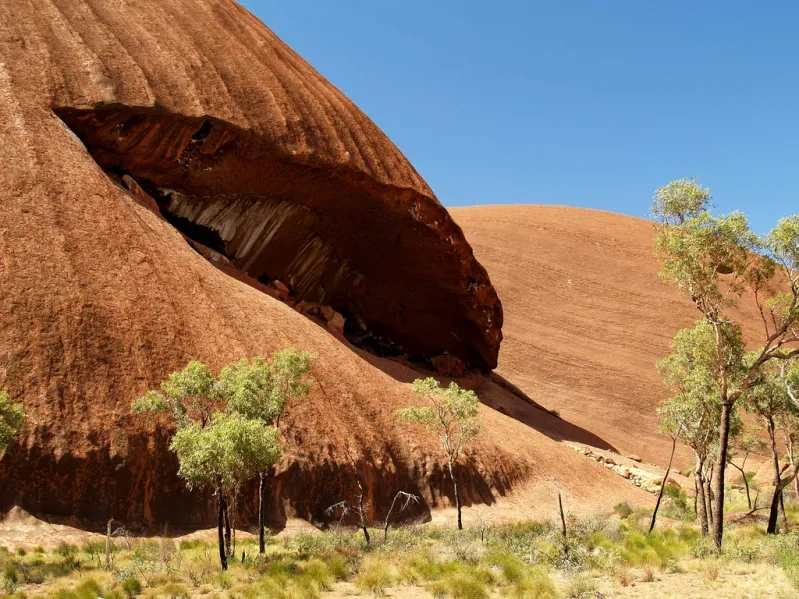Uluru is a UNESCO World Heritage Site, one of the main natural attractions in Australia, which attracts more than 400 thousand people every year. Uluru is an orange-brown rock (the orange hue of Uluru is given by the iron oxide contained in its composition), capable of changing color at different times of the day. At dawn, the silhouette of the rock brightens, acquiring a dark purple hue. The sun rises higher and higher and Uluru flashes purple-red, then glows pink, and turns golden by noon.
 |
| Uluru Australia |
You can come across different points of view of what Uluru really is. Some write that this is the second largest (after the Australian Augustus) monolith in the world, others argue that Uluru is not a monolith at all, since underground Uluru is connected to Mount Olga (the mountain was named after the daughter of the Russian Emperor Nicholas I - the Grand Duchess Olga), located 25 km. from Uluru. Thanks to a spring gushing in this area, the area near Uluru has been inhabited by people for 10 thousand years (even ancient rock paintings have been preserved here) and the aborigines have their own version of what Uluru is.
 |
| Uluru Australia |
Local legend says: on the sunny side of Uluru lived the Mala tribe (people - hare kangaroos), on the shady side lived another tribe - Kunia (snake people). Once, both of these tribes were invited by the Windulka tribe to a holiday, but the invitees were attracted by the lizard women who came to visit them. As a result, the owners of the holiday, to which no one came, got angry and sent angry dogs without hair with huge teeth (sometimes they say that they were dingoes), as well as poisonous snakes that lived near Mount Olga (the aboriginal name of the mountain is Kata Tjuta). As a result, a grandiose battle took place near Uluru and both tribes (Mala and Kunia) were exterminated. Uluru rose from the earth and enclosed the souls of the lost tribes. There is a belief: whoever takes even the slightest part of Uluru will be cursed, and many tourists confirm this belief:
 |
| Uluru Australia |
In 1985, the Australian government leased Uluru to the local Ananga tribe for 99 years, so the Australian aborigines are the official owners of these places. Aborigines do not impede the flow of tourists to Urul, because this is a good opportunity for the tribe to make money. The admission ticket, valid for three days, costs A $ 25 and 20% of each ticket goes to the Anangu tribe. Aboriginal people do not like it when tourists climb Uluru (its height is 348 meters) and have repeatedly appealed to the Australian government with a request to prohibit climbing the sacred rock for them. In addition, climbing Uluru is unsafe: 35 people have already died while trying to conquer the rock. If the aborigines have not yet achieved a ban on climbing, then one ban is very strict: you cannot take pictures in two places of Uluru.
 |
| Uluru Australia |
There is no tourist complex directly next to Uluru, so those wishing to visit the famous rock stop in the town of Yulara, which is 18 km away. from Uluru. If you try to translate the word "Uluru" from English (the official language of Australia), then nothing will come of it, because it is a word from the language of the local aborigines. However, scientists have not figured out the origin and meaning of the word "Uluru" in the aboriginal language. Sometimes this word can be used as a surname among the tribe living near Uluru. From 1873 to 1993, the official English name for this rock was Ayers Rock. In 1993, the Australian government decided to introduce dual names (English + local) for Australian natural sites and the rock was named Ayers Rock/ Uluru.
